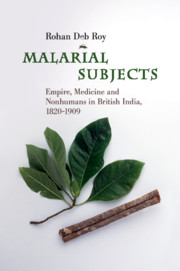Book contents
- Malarial Subjects
- Science in history
- Malarial Subjects
- Copyright page
- Dedication
- Contents
- Illustrations
- Acknowledgements
- Abbreviations
- Introduction
- 1 ‘Fairest of Peruvian Maids’
- 2 ‘An Imponderable Poison’
- 3 ‘A Cinchona Disease’
- 4 ‘Beating About the Bush’
- 5 Of ‘Losses Gladly Borne’
- 6 Epilogue
- Bibliography
- Index
- References
Bibliography
Published online by Cambridge University Press: 16 September 2017
- Malarial Subjects
- Science in history
- Malarial Subjects
- Copyright page
- Dedication
- Contents
- Illustrations
- Acknowledgements
- Abbreviations
- Introduction
- 1 ‘Fairest of Peruvian Maids’
- 2 ‘An Imponderable Poison’
- 3 ‘A Cinchona Disease’
- 4 ‘Beating About the Bush’
- 5 Of ‘Losses Gladly Borne’
- 6 Epilogue
- Bibliography
- Index
- References
Information
- Type
- Chapter
- Information
- Malarial SubjectsEmpire, Medicine and Nonhumans in British India, 1820–1909, pp. 304 - 323Publisher: Cambridge University PressPrint publication year: 2017
- Creative Commons
- This content is Open Access and distributed under the terms of the Creative Commons Attribution licence CC-BY-NC-ND 4.0 https://creativecommons.org/cclicenses/
